
NCERT Solutions for Class 12 Maths Chapter 1 Excercise 1.2 (Relations and Functions)
NCERT Solutions for Class 12 Maths Chapter 1 Excercise 1.2 Relations and Functions is prepared by academic team of Physics Wallah. We have prepared NCERT Solutions for all exercise of chapter 1. Given below is step by step solutions of all questions given in NCERT textbook for Chapter 1 Relations and FunctionsNCERT Solutions For Class 12 Maths Chapter 1 Overview
NCERT Solutions for Class 12 Maths Chapter 1 contains all the important topics for the exams. Our experts created these questions for the students to ace the examination. This article contains all the important questions and their easy to understand answers for the better understandingStudents are advised to go through these questions to clarify their concepts better. These questions are created to help students in the better understanding of the NCERT Solutions for Class 12 Maths Chapter 1
NCERT Solutions For Class 12 Maths Chapter 1 PDF
To help students understand and practise chapter concepts, our team of experts at Physics Wallah has developed thorough solutions for NCERT Class 12 Maths, Chapter 1. The purpose of these questions is to make explanations easier to understand for students. You can use the following link to obtain the NCERT Solutions for Class 12 Maths Chapter 1 Pdf.NCERT Solutions for Class 12 Maths Chapter 1 PDF Download Link
NCERT Solutions for Class 12 Physics
NCERT Solutions for Class 12 Maths Chapter 1 Excercise 1.2
Solve The Following Questions NCERT Solutions for Class 12 Maths Chapter 1 Excercise 1.2 of Relations and Functions:
Question 1. Show that the function f : R * → R * defined by f(x) = 1/x is one-one and onto, where : R * is the set of all non-zero real numbers. Is the result true, if the domain : R * is replaced by N with co-domain being same as : R * ? Solution :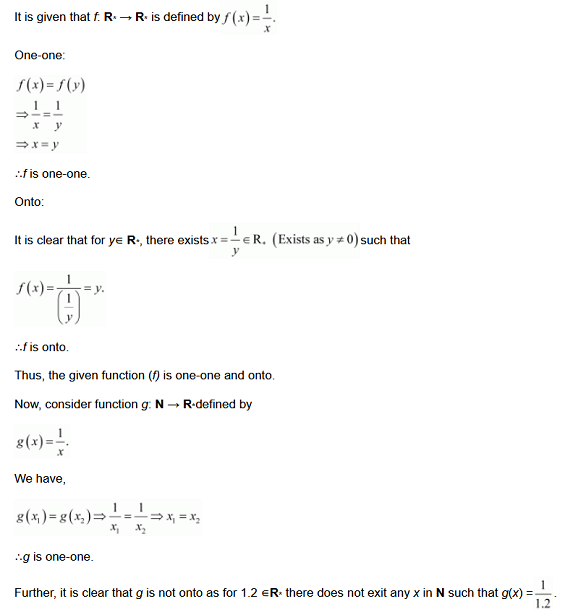 Hence, function g is one-one but not onto.
Hence, function g is one-one but not onto.
NCERT Solutions for Class 12 Maths Chapter 1 Exercise 1.1
Question 2. Check the injectivity and surjectivity of the following functions: (i) f: N → N given by f(x) = x 2 (ii) f: Z → Z given by f(x) = x 2 (iii) f: R → R given by f(x) = x 2 (iv) f: N → N given by f(x) = x 3 (v) f: Z → Z given by f(x) = x 3 Solution : (i) f: N → N is given by, f(x) = x 2 It is seen that for x, y ∈N, f(x) = f(y) ⇒ x 2 = y 2 ⇒ x = y. ∴f is injective. Now, 2 ∈ N. But, there does not exist any x in N such that f(x) = x 2 = 2. ∴ f is not surjective. Hence, function f is injective but not surjective. (ii) f: Z → Z is given by, f(x) = x 2 It is seen that f(−1) = f(1) = 1, but −1 ≠ 1. ∴ f is not injective. Now,−2 ∈ Z. But, there does not exist any element x ∈Z such that f(x) = x 2 = −2. ∴ f is not surjective. Hence, function f is neither injective nor surjective. (iii) f: R → R is given by, f(x) = x 2 It is seen that f(−1) = f(1) = 1, but −1 ≠ 1. ∴ f is not injective. Now,−2 ∈ R. But, there does not exist any element x ∈ R such that f(x) = x 2 = −2. ∴ f is not surjective. Hence, function f is neither injective nor surjective. (iv) f: N → N given by, f(x) = x 3 It is seen that for x, y ∈N, f(x) = f(y) ⇒ x 3 = y 3 ⇒ x = y. ∴f is injective. Now, 2 ∈ N. But, there does not exist any element x in domain N such that f(x) = x 3 = 2. ∴ f is not surjective Hence, function f is injective but not surjective. (v) f: Z → Z is given by, f(x) = x 3 It is seen that for x, y ∈ Z, f(x) = f(y) ⇒ x 3 = y 3 ⇒ x = y. ∴ f is injective. Now, 2 ∈ Z. But, there does not exist any element x in domain Z such that f(x) = x 3 = 2. ∴ f is not surjective. Hence, function f is injective but not surjective.NCERT Solutions for Class 12 Maths Chapter 1 Miscellaneous Exercise
Question 3. Prove that the Greatest Integer Function f: R → R given by f(x) = [x], is neither one-one nor onto, where [x] denotes the greatest integer less than or equal to x. Solution : f: R → R is given by, f(x) = [x] It is seen that f(1.2) = [1.2] = 1, f(1.9) = [1.9] = 1. ∴ f(1.2) = f(1.9), but 1.2 ≠ 1.9. ∴ f is not one-one. Now, consider 0.7 ∈ R. It is known that f(x) = [x] is always an integer. Thus, there does not exist any element x ∈ R such that f(x) = 0.7. ∴ f is not onto. Hence, the greatest integer function is neither one-one nor onto.NCERT Solutions for Class 12 Maths Chapter 1 Exercise 1.2
Question 4. Show that the Modulus Function f : R → R, given by f(x) = |x| is neither one-one nor onto, where is |x| if x is positive or 0 and |-x| is -x if x is negative. Solution :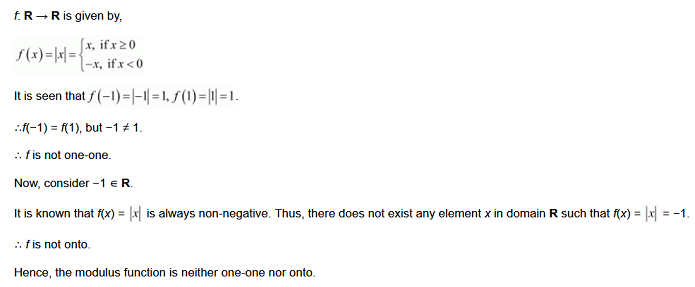
NCERT Solutions for Class 12 Maths Chapter 1 Exercise 1.3
Question 5. Show that the Signum Function f : R → R , given by is neither one-one nor onto. Solution : f : R → R
is neither one-one nor onto. Solution : f : R → R  It is seen that f(1) = f(2) = 1, but 1 ≠ 2. ∴ f is not one-one. Now, as f(x) ) takes only 3 values (1, 0, or −1) for the element −2 in co-domain R , there does not exist any x in domain R such that f(x) = −2. ∴ f is not onto. Hence, the signum function is neither one-one nor onto.
It is seen that f(1) = f(2) = 1, but 1 ≠ 2. ∴ f is not one-one. Now, as f(x) ) takes only 3 values (1, 0, or −1) for the element −2 in co-domain R , there does not exist any x in domain R such that f(x) = −2. ∴ f is not onto. Hence, the signum function is neither one-one nor onto.
NCERT Solutions for Class 12 Maths Chapter 1 Exercise 1.4
Question 6. Let A = {1, 2, 3}, B = {4, 5, 6, 7} and let f = {(1, 4), (2, 5), (3, 6)} be a function from A to B. Show that f is one-one. Solution : It is given that A = {1, 2, 3}, B = {4, 5, 6, 7}. f: A → B is defined as f = {(1, 4), (2, 5), (3, 6)}. ∴ f (1) = 4, f (2) = 5, f (3) = 6 It is seen that the images of distinct elements of A under f are distinct. Hence, function f is one-one. Question 7. In each of the following cases, state whether the function is one-one, onto or bijective. Justify your answer. (i) f: R → R defined by f(x) = 3 − 4x (ii) f: R → R defined by f(x) = 1 + x 2 Solution :Question 8. Let A and B be sets. Show that f: A × B → B × A such that (a, b) = (b, a) is bijective function. Solution :
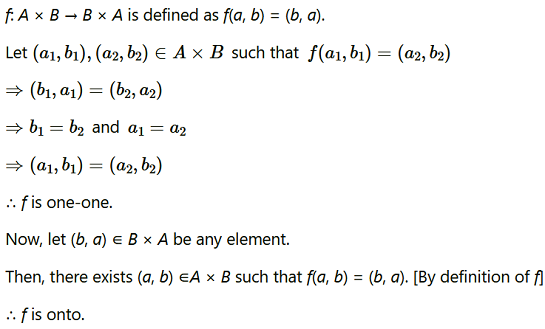 Question 9. Let N → N be defined by f(n) for all
Question 9. Let N → N be defined by f(n) for all  State whether the function f is bijective. Justify your answer. Solution :
State whether the function f is bijective. Justify your answer. Solution : 
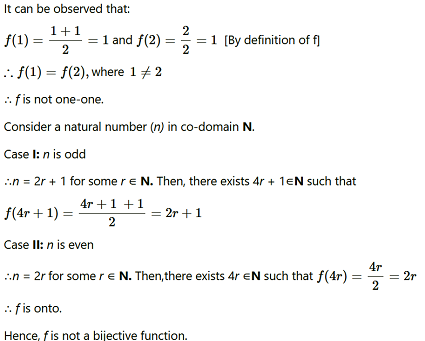 Question 10. Let A = R – {3} and B = R – {1}. Consider the function f : A → B defined by f(x) = (x-2/x-3) Is f one-one and onto? Justify your answer. Solution : A = R – {3} and B = R – {1} f : A → B defined by f(x) = (x-2/x-3) Let x, y ∈ A such that f(x) = f(y)
Question 10. Let A = R – {3} and B = R – {1}. Consider the function f : A → B defined by f(x) = (x-2/x-3) Is f one-one and onto? Justify your answer. Solution : A = R – {3} and B = R – {1} f : A → B defined by f(x) = (x-2/x-3) Let x, y ∈ A such that f(x) = f(y) 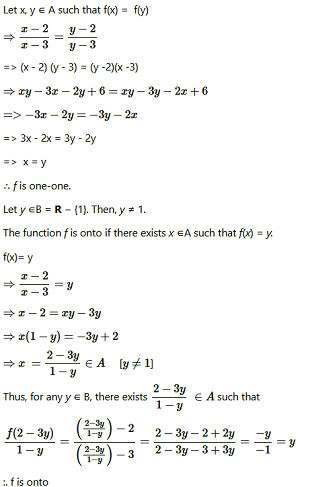 Hence, function f is one-one and onto. Question 11. Let f: R → R be defined as f(x) = x 4 . Choose the correct answer. (A) f is one-one onto (B) f is many-one onto (C) f is one-one but not onto (D) f is neither one-one nor onto Solution : f: R→ R is defined as f(x) = x 4 .
Hence, function f is one-one and onto. Question 11. Let f: R → R be defined as f(x) = x 4 . Choose the correct answer. (A) f is one-one onto (B) f is many-one onto (C) f is one-one but not onto (D) f is neither one-one nor onto Solution : f: R→ R is defined as f(x) = x 4 .
Let ,x, y ∈ R such that f(x) = f(y).
⇒ x 4 = y 4 ⇒ x = ±y ∴f(x 1 ) = f ( x2 ) does not imply that x 1 = x 2 For instance, f(1) = f(-1) = 1 ∴ f is not one-one. Consider an element 2 in co-domain R . It is clear that there does not exist any x in domain R such that f(x) = 2. ∴ f is not onto. Hence, function f is neither one-one nor onto. The correct answer is D. Question 12. Let f: R → R be defined as f(x) = 3x. Choose the correct answer. (A) f is one-one onto (B) f is many-one onto (C) f is one-one but not onto (D) f is neither one-one nor onto Solution : f: R → R be defined as f(x) = 3x.Let ,x, y ∈ R such that f(x) = f(y).
⇒ 3x = 3y ⇒ x = y ∴ f is one - one Also, for any real number (y) in co-domain R, there exists y/3 in R such that f(y/3) = 3(y/3) = y ∴ f is onto. Hence, function f is one-one and onto. The correct answer is A.NCERT Solutions for Class 12 Maths Chapter 1 Excercise 1.2 FAQs
What does Exercise 1.2 in Class 12 Maths Chapter 1 cover?
Exercise 1.2 in Class 12 Maths Chapter 1 typically covers more advanced problems related to relations and functions. It may include questions on types of relations, equivalence relations, and composition of functions.
How many questions are there in Exercise 1.2 of Class 12 Maths Chapter 1?
The number of questions in Exercise 1.2 can vary based on the specific textbook or curriculum. Usually, it includes a set of problems to reinforce the understanding of advanced concepts introduced in the chapter.
What are the key topics addressed in Exercise 1.2?
Exercise 1.2 often deals with types of relations such as reflexive, symmetric, and transitive relations. It may also cover equivalence relations and the composition of functions.
Are Exercise 1.2 questions more challenging than Exercise 1.1?
Yes, Exercise 1.2 questions are generally more advanced and may require a deeper understanding of the concepts introduced in Exercise 1.1. They often involve higher-order thinking and problem-solving skills.
How can I prepare for Exercise 1.2 questions?
Review the concepts from Exercise 1.1 thoroughly. Understand the definitions and properties related to different types of relations and functions. Practice solving similar problems and seek guidance from your teacher if needed.
🔥 Trending Blogs
Talk to a counsellorHave doubts? Our support team will be happy to assist you!

Free Learning Resources
PW Books
Notes (Class 10-12)
PW Study Materials
Notes (Class 6-9)
Ncert Solutions
Govt Exams
Class 6th to 12th Online Courses
Govt Job Exams Courses
UPSC Coaching
Defence Exam Coaching
Gate Exam Coaching
Other Exams
Know about Physics Wallah
Physics Wallah is an Indian edtech platform that provides accessible & comprehensive learning experiences to students from Class 6th to postgraduate level. We also provide extensive NCERT solutions, sample paper, NEET, JEE Mains, BITSAT previous year papers & more such resources to students. Physics Wallah also caters to over 3.5 million registered students and over 78 lakh+ Youtube subscribers with 4.8 rating on its app.
We Stand Out because
We provide students with intensive courses with India’s qualified & experienced faculties & mentors. PW strives to make the learning experience comprehensive and accessible for students of all sections of society. We believe in empowering every single student who couldn't dream of a good career in engineering and medical field earlier.
Our Key Focus Areas
Physics Wallah's main focus is to make the learning experience as economical as possible for all students. With our affordable courses like Lakshya, Udaan and Arjuna and many others, we have been able to provide a platform for lakhs of aspirants. From providing Chemistry, Maths, Physics formula to giving e-books of eminent authors like RD Sharma, RS Aggarwal and Lakhmir Singh, PW focuses on every single student's need for preparation.
What Makes Us Different
Physics Wallah strives to develop a comprehensive pedagogical structure for students, where they get a state-of-the-art learning experience with study material and resources. Apart from catering students preparing for JEE Mains and NEET, PW also provides study material for each state board like Uttar Pradesh, Bihar, and others
Copyright © 2025 Physicswallah Limited All rights reserved.
Get App









